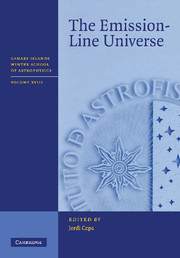Book contents
- Frontmatter
- Contents
- List of contributors
- List of participants
- Preface
- Acknowledgements
- 1 What can emission lines tell us?
- 2 The observer's perspective: Emission-line surveys
- 3 The astrophysics of early galaxy formation
- 4 Primeval galaxies
- 5 Active galactic nuclei
- 6 Chemical evolution
- 7 Galactic sources of emission lines
- 8 Narrow-band imaging
- 9 Long-slit spectroscopy
- 10 Basic principles of tunable filters
2 - The observer's perspective: Emission-line surveys
Published online by Cambridge University Press: 23 November 2009
- Frontmatter
- Contents
- List of contributors
- List of participants
- Preface
- Acknowledgements
- 1 What can emission lines tell us?
- 2 The observer's perspective: Emission-line surveys
- 3 The astrophysics of early galaxy formation
- 4 Primeval galaxies
- 5 Active galactic nuclei
- 6 Chemical evolution
- 7 Galactic sources of emission lines
- 8 Narrow-band imaging
- 9 Long-slit spectroscopy
- 10 Basic principles of tunable filters
Summary
Introduction
The goal of emission-line surveys is to identify a preselected class of astrophysical sources by means of emission lines in their spectral energy distribution. The techniques vary, depending on the sources, the spectral region and even the exact wavelength at which the observations are made, the desired sensitivity of the survey, and the volume of space that it aims to cover. But the basic methodology remains the same: exploiting the fact that emission lines in the spectrum of astronomical sources radiate significantly more luminosity over a relatively small wavelength interval than the continuum emission does over the same, or even larger, intervals in nearby portions of the spectrum. The excess luminosity, quantitatively expressed as the equivalent width of the line, enhances the signal-to-noise ratio of measures of the line flux for those sources whose emission lines satisfy the selection criteria of the survey, allowing the observer to cull them from otherwise similar sources.
Operationally, emission-line surveys exploit the presence of emission lines to substantially improve the detection rate of a particular class of astrophysical sources for which other methods of investigation would be significantly more inefficient or even outright impossible. The typical targets of these surveys are either sources that are too faint to detect by means of their continuum emission or sources that are rare and/or inconspicuous, and hence very difficult to recognize from all the other sources of similar apparent luminosity and/or morphology that crowd images made using the continuum emission.
- Type
- Chapter
- Information
- The Emission-Line Universe , pp. 41 - 65Publisher: Cambridge University PressPrint publication year: 2008



